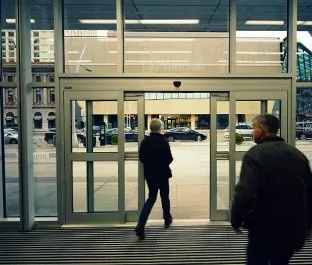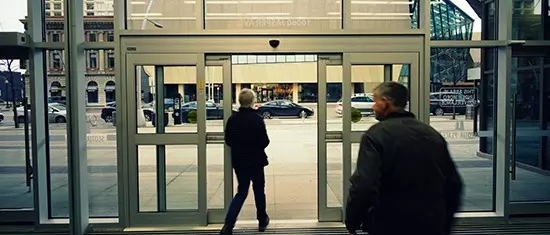Automated door and barrier safety involve more than merely identifying the individual components that make the product. It's more how the parts work in synergy to fit a particular set of circumstances, and what actions are taken over time to maintain overall safety.
Powered doors must always respond safely to human interaction. Barrier design must take into account that predictable interactions may exceed normal recommended use such as children playing on, around, or with the powered doors, as well as normal wear and tear. Similarly, adverse weather conditions such as heavy wind, rain, snow, and other debris can impair functionality.

Delivering protection by design and construction
Much is dependent on how the various components are assembled and integrated in response to particular environmental use. A combination of methods usually delivers protection that includes a design to eliminate potential problems such as the powered barrier running away down a slope, coming off its tracks, or falling over.
Other potential risks to be eliminated include securing holes at the movable mechanisms. This is a risk as it could potentially create forceful compression points and access to parts of the mechanism or holes between the moving leaf or leaves, fixed elements and open spaces in the railings. This may result in heads getting stuck.
Stability and capacity of the reinforcements and framework are designed to thwart strong forces as a result of the door's weight as it moves, as well as the effects of air mass to minimise adverse impact on actuators and sensing systems. Fixed guarding is used to prevent or restrict the ability to depress gears, for example, from warding off the back of sliding doors to circumvent other problems between the barrier leaf and fixed parts, etc.
Speed control and deceleration are used when coming to the end of any type of movement where forceful compression may arise.Limitation of the power that can be applied by moving pieces (which may be delivered within the motor), or in conjunction with external security mechanisms, where compression or impact dangers exist to detect and lessen the impact with an obstruction.
Non-contact Sensors:
Many of these are solely designed to prevent doors from shutting on vehicles. (It is important to note that these beams are not usually reliable safety devices and can be easily circumnavigated, for example, by stepping over). However, the probability of contact with the moving barrier could be reduced if doubled up (two beams at different heights on the public side of the door); Though less common due to cost, higher integrity safety elements such as safety beams may be deployed to disallow contact with the moving doors.
Door Operation: hold-to-run or automatic?
The overall network operation as delivered by the network controller link to external website. For example, not just ceasing when coming into contact with an obstacle, but also backing up even a short distance to avoid entrapment. Being held, but not crushed, can still be dangerous if no rescue is available.
The network is dependent upon the compatibility of and the connections between the various parts. For example, doors using category two controllers are only capable of delivering an overall category two system, even if the other components are manufactured to category three specifications.
Additionally, it is important to note that if other if all other components are not correctly connected to the controller, the overall safety network may not even achieve category 2, as this requires that a safety-related fault is detected no later than the end of the next movement.

Safety is also affected by the way in which the network has been wired both during and after installation. Product quality and physical protection of wiring and the connections between components is an integral part of resisting damage, deterioration and water ingress that may cause the loss of the function, such as short-circuiting.
Another concern is the way in which doors respond when any of the protective features are activated. It is essential that the system's response creates no additional risks. An example of this situation is how the barrier would respond when it reverses after having encountered an obstruction. Accordingly, safety can also be affected by how the network is subsequently maintained. How the parts wear in response to environmental conditions such as extreme weather play a determining role in overall protection.
Through adequate risk assessment, the factors mentioned above must be considered as part of the initial design, specification, and construction. Appropriate information should be included in the User Instructions, as well as the suggested routine maintenance and periodic checks. If force limitation is the strategy employed, details of specific force tests should be provided. Lifetime product safety depends not only on design and construction but also in the way it is used and cared for, often by those not involved in the original design and construction.
